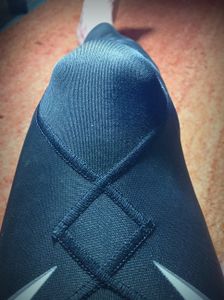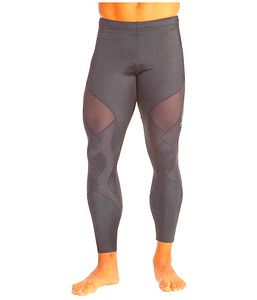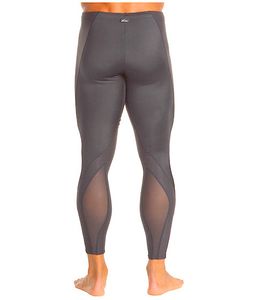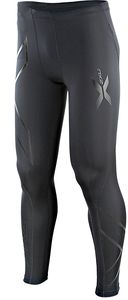A review of graduated compression wear
I've tried a number of different graduated compression bottoms for both recovery and training. I was initially skeptical of the benefits of compression clothing, but I've become a believer over time. My review of the available research indicates that compression clothing is a worthwhile investment. Personally, I found wearing compression clothing while training improves comfort and reduces leg pain. I have also found that wearing compression clothing makes a significant difference to recovery. Recovery compression tights reduce discomfort while they are worn, and they also reduce overall recovery times. I even sleep in compression tights on occasion.
Contents
1 Calf Sleeves
Calf sleeves are cheaper and more popular than full tights and offer most of the advantages. I prefer to run in the 2XU sleeves, and have the Zoot Ultra as a spare pair. I often wear the Zensah sleeves for recovery.
1.1 Summary of calf compression sleeves
| Type | Recommendation | Overall Rating | Colors | Number of sizes | Min size
(inches) |
Max size
(inches) |
Size Increments | Elasticity | Taper | Thickness | Compression top | Compression Bottom | Compression ratio | Length (inches) | Comfort | Size Tested |
|---|---|---|---|---|---|---|---|---|---|---|---|---|---|---|---|---|
| 2XU Calf Guards | Top Pick | 10.0 | Black/White/Red/Blue | 6 | 13.0 | 19.0 | 1.0"-1.5" | 48% | 36% | 1.5 | 3 | 4 | 20% | 10.5 | 8 | SM: 14.0"-15.5" |
| Zoot Ultra | A good second | 9.5 | Black/White | 5 | 12.0 | 20.0 | 1.0"-2.0" | 36% | 21% | 5.0 | 4 | 4 | 0% | 12 | 7 | 3: 14.5"-16.0 |
| CEP | Consider for high compression | 7.0 | Black/White/Blue/Red/etc. | 4 | 9.5 | 20.0 | 2.0" - 2.5" | 47% | 77% | 4.0 | 8 | 10 | 20% | 13 | 5 | 3: 12.5"-15.0" |
| Zensah | Good if they fit | 6.5 | Lots, including White | 3 | 9.0 | 15.0 | 2.5"-3.5" | 29% | 53% | 7.0 | 5 | 4 | -29% | 11 | 9 | MD: 12.5" – 15.5" |
| Mizuno | Not recommended | 5.0 | Black with highlights | 4 | 11.0 | 18.25 | 2.25"-2.5" | 38% | 47% | 6.0 | 5 | 4 | -20% | 14 | 5 | MD: 12.5"-15.0" |
| CW-X Revolution | Not recommended unless you want low compression | 4.5 | Black/White | 4 | 12.0 | 16.5 | 1.5" | 43% | 56% | 2.0 | 2 | 2 | -10% | 13 | 8 | MD: 13.5" – 15.5" |
| Zoot Performance | Not recommended | 2.0 | Black/White | 4 | 13.5 | 20.0 | 1.0"-2.0" | 21% | 35% | 3.0 | 8 | 7 | -20% | 11 | 3 | MD: 14.5" – 16.0" |
| Skins | Not recommended | 1.0 | Black/White | 5 | 12.0 | 20.0 | 1.0"-1.5" | 50% | 40% | 1.8 | 2 | 2 | 0% | 12 | 9 | SM: 14" – 15" |
| Salomon Exo IV | Not recommended | 0.0 | Black/White | 5 | 11.4 | 17.3 | 0.8" | 11% | 67% | 2.5 | 5 | 3 | -43% | 12 | 1 | MD: 14.2" – 15.0" |
1.1.1 Explanation of columns
I've gathered a number of details on each of the compression calf sleeves I evaluated. With these calf sleeves, getting the right fit is critical to getting the right compression.
- Overall Rating. The sleeves are ordered by rating, but this number is intended to give a sense of their relative merits.
- Color. For best performance in warm conditions, go for white sleeves.
- Sizes. The more sizes that are available, the better your chance of getting the right fit. If you have larger or smaller calves, you may be more limited in your options.
- Size Increments. A small size increment tends to imply less flexibility in the fit.
- Elasticity. The more elastic a sleeve is, the wider the range of calf and ankle sizes it will work for. Not only is it harder to get the right fit with an inflexible sleeve, changes in your muscle size will cause bigger changes in compression. (Muscles tend to swell slightly during exercise.)
- Taper. These sleeves all taper from the top to the bottom, ideally following the shape of your calf. The taper is the ratio between the size at the top and the size at the bottom. If you have larger calf muscles with small ankles, you need a high ratio. Similarly, if you have small calf muscles or larger angles, you need a lower ratio.
- Thickness. A thinner sleeve is generally better than a thicker sleeve in warm conditions.
- Compression top/bottom. This is an estimate of how much pressure each sleeve provides. The actual pressure will depend on how well the sleeve fits you, so use this as a rough guide.
- Compression ratio. This is how much pressure is provided at the bottom compared with the top. It's generally recommended that there is more compression at the bottom than the top. A negative value indicates more compression at the top than the bottom.
- Comfort. This is how comfortable I found the sleeves.
- Length. This is the length I measured wearing the sleeves and different sizes will have different lengths, so use this as a relative guide. Longer sleeves that come lower down the ankle tend to put more pressure on the Achilles tendon, which can cause problems.
- Size tested. This is the size I tested, and my calves measure about 14.5 inches so you can see where I fall in the size range.
1.2 2XU Guard Calf Sleeves
These 2XU sleeves are my favorites of those I tested. They have plenty of elasticity combined with 6 different sizes, so they are most likely to fit well, and provide a reasonable level of compression. The thin material and the white color are ideal for warmer conditions and they stay in place well. They are also the only sleeves I tested with reflective strips, a useful safety feature when running in the dark. (Note that 2XU also make a 'Calf Sleeve' without 'Guard' in which is intended for recovery.)
1.3 Zoot Ultra Calf Sleeves
The Zoot Ultra sleeves are quite similar to the 2XU sleeves. Compared with the 2UX they are not quite as elastic, not quite a thin and not quite as comfortable, but they come a close second. I found they did not stay up quite as well as the 2XU, and I found the length caused me some minor Achilles tendon problems.
1.4 CEP Compression Sleeves
The CEP sleeves are much tighter than I would recommend, especially around the lower part of the calf and ankle. Even though they have reasonable elasticity, each size has to cover a wide range of calf circumferences. They only come in four sizes with no overlap so getting the right fit may be tricky, compounding the tightness issues. The CEP sleeves are quite long and I find they annoyed my Achilles tendon (I don't typically have Achilles issues). On the positive side, the CEP sleeves are reasonably thin, they stay in place well, and there is no band at the top or bottom of the sleeve. I tried the CEP sleeves in the next size up from the recommended size and while this improved the comfort, the compression was still rather high. (Note that CEP come in men's and women's, with the largest size only in men's and the smallest only in women's.)
1.5 Zensah Calf Sleeves
The Zensah sleeves were remarkably comfortable and are available in a wide range of colors. However, they fell down with the most limited range of sizes and poor elasticity, making it hard to get the right fit. If the Zensah sleeves fit you then they are a good choice for cooler conditions or recovery, but their thickness makes them rather warm. I love my Zensah sleeves for recovery, but that's because I got lucky with the sizing.
1.6 Mizuno Calf Sleeves
I found that the Mizuno calf sleeves were not as comfortable as those higher on my list. They do have a higher level of compression, and good elasticity, but if you want something with more pressure, look at the CEP sleeves.
1.7 CW-X Revolution Calf Sleeves
The CW-X Revolution sleeves do not have enough compression in my opinion. However, if you're looking for a gentle sleeve, these are worth considering. They have great elasticity and they're nice and thin. These sleeves also make a good choice for sleeping in to improve recovery.
1.8 Zoot Performance Calf Sleeves
The Zoot Performance sleeves had too much compression combined with too little elasticity. I was on the edge of two sizes and chose the larger, so they would have even higher compressions for most people.
1.9 Skins Calf Sleeves
The Skins sleeves are the most comfortable sleeves I tried, mostly because they provide so little compression. Without the compression, these do not seem worth buying.
1.10 Salomon Exo IV
The best word to summarize the Salomon Exo IV is 'horrible'. They have almost no elasticity, so the chance of getting a good fit is extremely low, and the level of compression they provide is likely to change significantly as your muscles warm up and expand.
2 Compression Socks
I have not included any compression socks in my reviews because I don't think they are a good idea. The primary problem with compression socks is that they put pressure on the foot in ways the foot was not designed to handle. Pressure that squashes the foot from the side can result in a Morton's Neuroma or other problems with the nerves. A secondary problem with compression socks is that they are much harder to size as you have to take into account the size of your foot as well as the size of your calf. In theory the advantage of compression socks is that they help prevent any swelling in the feet, but in practice I've seen few problems with just compression sleeves or tights.
3 Compression Shorts
While I like form fitting shorts, I'm not a fan of true compression shorts, preferring either full tights or just calf sleeves. The combination of compression shorts and compression calf sleeves seems like a poor choice, as the lower edge of the shorts and the upper edge of the calf sleeves will tend to reduce circulation compared with full tights.
4 Training Tights
These tights are explicitly designed for use while running and training.
4.1 Race Ready LD Compression Tights (highly recommended)
I would estimate that I run in Race Ready's compression shorts or tights for 99% of my runs. The "LD" stands for long distance, and refers to the mesh pockets around the back of the waistband. I find these invaluable, and I typically have my portable pharmacy, pepper spray, gels, MP3 player, a more tucked in them. They even have a small internal key pocket to round out there carrying capacity. There are also remarkably comfortable. The only real downside is that they are not what I would consider "compression." They are formfitting, but don't really apply any pressure, and certainly no graduated pressure. Race Ready LD Compression Tights
4.2 2XU Elite Compression Tight (highly recommended)
 These are my 2XU with the pockets from an old pair of Race Ready Shorts. |
These are my preferred running tights, with a useful level of compression. My wife added in some extra pockets in the back from some old Race Ready shorts, which was far harder than we anticipated. The latest version of these tights comes with a key pocket, and a waistband with a fastening cord which I upgrade with a toggle. Like all graduated compression tights, they do tend to slip down slightly, but the waistband keeps them in place. I find they are far more comfortable than Form Fitting tights and I miss them if I run in my 'ordinary' tights. 2XU Elite Compression Tight at Zappos, also available as the cheaper 'non pro' version, but the Pro is worth the extra.
4.3 Saucony Men's AMP PRO2 Training Tight (worth considering)
The Saucony training tights are higher compression than their recovery version, but less pressure than the Zoot Active, and similar to the 2XU. These are the only compression tights I've tried that have an ankle zipper, which is rather nice. I like these tights, but the lack of waist band is remarkably annoying as they tend to slip down while running. These are one of the few compression tights with a pocket, which is zippered and in the small of the back. They are currently on sale from Sierra Trading Post for $60.
4.4 Zoot CompressRx Active Tight (worth considering)
These tights offer high levels of compression and use a variable weave to apply the different pressure to specific areas. This variable weave is the most technically advanced of the tights I've tried, and this is a more effective approach than the extra material used in the CW-X shown below. This targeted compression should help to support and position the kneecap without applying direct pressure, and allow for more freedom of movement. The knee support might help with Knee Pain. The tights are a little tricky to put on, and the lack of distinct waistband causes them to slip down more than the Saucony. They have are no pockets, which I miss. While I liked the targeted high compression, the extra tension made them slip down too often to be viable. If Zoot changed the design to include a waistband, I order a pair immediately. These may be worth trying to see if they stay up for you. Zoot CompressRx Active Tight at amazon.com
4.5 CW-X Stabilyx Tights
The Stabilyx tights are intended to provide extra pressure along certain lines to help align muscles and bones. This extra pressure comes from a second layer of material, so these tights are quite a bit thicker, less flexible and warmer than other tights such as the 2XU or Zoot. There is also rather more vertical tension, pulling the tights down at the waistband, which is a little uncomfortable. I was hoping that the tights would provide more knee support than other tights, but as you can see from the pictures, the extra supporting bands are some distance from the kneecap. If you like the idea of variable compression, then I'd suggest the Zoot approach of using different weaves of material is superior to the CW-X approach of adding a second layer. CW-X does have a similar approach in their Revolution tights, but these are rather expensive and don't provide as much compression. Like the Zoot, the targeted compression might help with Knee Pain, but I suspect the support webs are too far from the kneecap to make much difference (see pictures). CW-X at Zappos.com.
4.6 CW-X Ventilator Tights
These compression tights have mesh panels to reduce the heat buildup. While this makes them cooler than the standard CW-X Stabilyx, they are still warmer than other tights like the 2XU. If you prefer the CW-X style of support webbing, then these are a better option than the standard tights until the weather gets cold. CW-X Ventilator at Zappos.com.
5 Recovery Tights
I have quite a variety of recovery tights, but I found that I nearly always wear the Saucony AMP PRO2. Sadly, they've been out of production for some time, and both my pairs are showing their age. They are so comfortable, that I wear them whenever my training becomes intense. I've been looking for replacements, something that's is equally comfortable, and so far, nothing has come close.
5.1 Saucony AMP PRO2 Recovery Tight (highly recommended, unobtainable)
These are my favorite recovery tights with mild compression and remarkable comfort. They have no waistband, but I have no problems with them slipping down. I wear these during the day under jeans and sometimes sleep in them. They are made of a material called Cellaint that claims to have special properties that help reduce pain, with some reasonable science based on treatment of diabetic patients. I'm not sure if it's the material or the design, but these are by far the most comfortable compression wear. If you get the chance to buy a pair, I'd highly recommend it, but they becoming impossible to find as of early 2018. However, they are the standard by which I measure all other recovery tights.
5.2 SKINS Men's DNAmic Compression Recovery Tights (Highly Recommended)
These are the nearest I found to the Saucony tights. They provide a little more compression, which is rather nice, but they're not so comfortable. They have a waistband, but no drawstring. They tend to slip down a little, though nowhere near as bad as many recovery tights do. The sizing seems a fairly accurate, and they're reasonably easy to put on. The material is a little thinner than the Saucony, which means they're not quite so warm, a slight advantage in the warmer months. The material is not quite so nice against my skin as the Saucony, but the Saucony is second to none in that respect. Error: Could not parse data from Amazon!.
5.3 2XU Compression Recovery Tight (Recommended)
While these tights and not as comfortable as the Saucony's, they provide a little more compression. They have a good waistband, with a drawstring which prevents them from falling down. Initially I was wearing these nearly as often as the Saucony, but I found that having the drawstring tight enough to stop them slipping down is rather uncomfortable. I think part of the problem is the style doesn't come up far enough to the waist to have a firm naturally stay in place. 2XU Compression Recovery Tight at zappos.com
5.4 Skins RY400 Compression Tights (worth considering)
These tights mixed bag. I like the thin material around the knee area which reduces pressure on the kneecap, and allows the knee to bend easily. I also like the thin material which is cooler in warm weather. These tights have a strong waistband, which should be a good thing. Unfortunately, the waistband is a little too tight, and is not adjustable. Worse, the waistband is a thick piece of elastic that tends to get twisted inside the tights and become comfortable. These are worth considering, but I only have a pair because they were on sale at a particularly low price. Skins RY400 at amazon.com
5.5 Zoot CompressRx Recovery and Travel Tight (Worth considering)
These tights have the highest compression of any I've tried. They include compression over the foot and a complex weave that varies the level of compression over the leg. This includes lower compression over the kneecap for instance. This is a nice idea, but I found it quite tricky to get the right patches of lined up. Even then, the difference in compression between areas is not that great. These are far less comfortable than my Saucony recovery tights, but the higher compression makes them worth owning. I found these tights too low rise, with a baggy waistband so they tend to slide down more than any other tights I've tried. I had to sow tucks into the waistband so that I could wear them without having to continually pull them up, which helped a little. I also ended up cutting the foot off, as this was aggravating my Mortons Neuroma as well as being quite uncomfortable. Zoot CompressRx Recovery and Travel Tight at amazon.com
5.6 2XU Men's Elite Power Recovery Compression Tights
I found these 2XU tights to be hard work to put on, though I'm at the low end of their size recommendation. This might be because I have somewhat more muscular legs than my height and weight would suggest, but the size I wore is intended to fit someone weighing nearly 30 pounds more than I do. I'm not a big fan of the foot compression, though this can always be cut off if need be. However, the opening in the bottom seemed to produce a hard edge that bit into the skin around the ankle rather badly. The material also seems harder and harsher against my skin. 2XU Men's Elite Power Recovery Compression Tights.
5.7 Zensah Recovery Tight
I had high hopes for the Zensah recovery tights, as their calf sleeves are quite comfortable. Unfortunately, while they are a little more flexible than the cost sleeves, their sizes span quite a wide range as it they only produce 3 sizes, XS/S, S/M, L/XL. I tried both the XS/S and the S/M and neither fitted properly. The relative lack of elasticity mentor they were both hard to get on, whilst providing less compression than the Skins DNAmic. The material is far thicker than any other compression tights I've tried which means that they'd probably be a little warm in many situations. These tights use variable weave to produce different areas with different levels of pressure, which seems like a good idea, but the execution doesn't live up to the promise. I like the idea of a seamless construction, but in practice, the Saucony tights are the most comfortable even though they have seams. These tights have a shoelace drawstring which helps them stay up, but over time I find the extra pressure on the abdomen and on the skin above my hip bones quite uncomfortable. Zensah Recovery Tight
5.8 SKINS Travel and Recovery Tights
These tights have similar compression to the Saucony tights, but with foot compression. They are also thinner than the Saucony so they are cooler, but not as comfortable. I did not get on with these tights and sent them back. SKINS Travel and Recovery Tights at amazon.com























